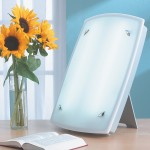
Major depressive disorder is a prevalent and debilitating condition in elderly patients. It is accompanied by circadian rhythm disturbances associated with impaired functioning of the suprachiasmatic nucleus, the biological clock of the brain. Circadian rhythm disturbances are common in the elderly. Suprachiasmatic nucleus stimulation using bright light treatment may, therefore, improve mood, sleep, and hormonal rhythms in depressed elderly patients.
This double-blind, placebo-controlled randomised controlled trial investigated the efficacy of bright light treatment in elderly patients with major depressive disorder. The setting for the trial was home-based treatment in patients recruited from outpatient clinics and from case-finding using general practitioners’ offices in the Amsterdam region.
The study randomised 89 outpatients (who all had major depressive disorder and were 60 years or older) to either:
- Three weeks of 1-hour early-morning bright light treatment (pale blue, approximately 7500 lux), or
- Three weeks of 1-hour early-morning dim red light, approximately 50 lux (the placebo intervention)
Patients were assessed at baseline (T0), after 3 weeks of treatment (T1) and 3 weeks after the end of treatment (T2) and mean improvement was measured using the Hamilton Scale for Depression scores using parameters of sleep and cortisol and melatonin levels.
The researchers conducted an intention-to-treat analysis that showed:
Hamilton Scale for Depression scores improved with bright light treatment more than placebo:
- From T0 to T1 (7%; 95% confidence interval, 4%-23%; P = .03)
- From T0 to T2 (21%; 7%-31%; P = .001)
At T1 relative to T0:
- Get-up time after final awakening in the bright light treatment group advanced by 7% (P < .001)
- Sleep efficiency increased by 2% (P = .01)
- The steepness of the rise in evening melatonin levels increased by 81% (P = .03) compared with the placebo group
At T2 relative to T0:
- Get-up time was still advanced by 3% (P = .001)
- The 24-hour urinary free cortisol level was 37% lower (P = .003) compared with the placebo group
- The evening salivary cortisol level had decreased by 34% in the BLT group compared with an increase of 7% in the placebo group (P = .02).
The researchers concluded:
In elderly patients with major depressive disorder, bright light treatment improved mood, enhanced sleep efficiency, and increased the upslope melatonin level gradient. In addition, bright light treatment produced continuing improvement in mood and an attenuation of cortisol hyperexcretion after discontinuation of treatment.
Lieverse R, Van Someren EJ, Nielen MM, Uitdehaag BM, Smit JH, Hoogendijk WJ. Bright light treatment in elderly patients with nonseasonal major depressive disorder: a randomized placebo-controlled trial. Arch Gen Psychiatry. 2011 Jan;68(1):61-70. [PubMed abstract]
